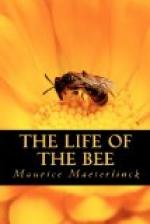And further, we might mention what M. Georges de Layens, the celebrated French apiarist, terms the “Distribution of Bees over Melliferous Plants.” Day after day, at the first hour of sunrise, the explorers of the dawn return, and the hive awakes to receive the good news of the earth. “The lime trees are blossoming to-day on the banks of the canal.” “The grass by the roadside is gay with white clover.” “The sage and the lotus are about to open.” “The mignonette, the lilies are overflowing with pollen.” Whereupon the bees must organise quickly, and arrange to divide the work. Five thousand of the sturdiest will sully forth to the lime trees, while three thousand juniors go and refresh the white clover. Those who yesterday were absorbing nectar from the corollas will to-day repose their tongue and the glands of their sac, and gather red pollen from the mignonette, or yellow pollen from the tall lilies; for never shall you see a bee collecting or mixing pollen of a different colour or species; and indeed one of the chief pre-occupations of the hive is the methodical bestowal of these pollens in the store-rooms, in strict accordance with their origin and colour. Thus does the hidden genius issue its commands. The workers immediately sally forth, in long black files, whereof each one will fly straight to its allotted task. “The bees,” says De Layens, “would seem to be perfectly informed as to the locality, the relative melliferous value, and the distance of every melliferous plant within a certain radius from the hive.
“If we carefully note the different directions in which these foragers fly, and observe in detail the harvest they gather from the various plants around, we shall find that the workers distribute themselves over the flowers in proportion not only to the numbers of flowers of one species, but also to their melliferous value. Nay, more—they make daily calculations as to the means of obtaining the greatest possible wealth of saccharine liquid. In the spring, for instance, after the willows have bloomed, when the fields still are bare, and the first flowers of the woods are the one resource of the bees, we shall see them eagerly visiting gorse and violets, lungworts and anemones. But, a few days later, when fields of cabbage and colza begin to flower in sufficient abundance, we shall find that the bees will almost entirely forsake the plants in the woods, though these be still in full blossom, and will confine their visits to the flowers of cabbage and colza alone. In this fashion they regulate, day by day, their distribution over the plants, so as to collect the greatest value of saccharine liquid in the least possible time.
“It may fairly be claimed, therefore, for the colony of bees that, in its harvesting labours no less than in its internal economy, it is able to establish a rational distribution of the number of workers without ever disturbing the principle of the division of labour.”




